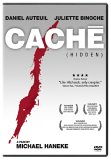Synopsis
Daniel Auteuil, host of a literary TV talk show, and his wife Juliette Binoche begin receiving strange videotapes. These are hours-long recordings of the front of their house. Nothing else. No explanations. Then child-like but disturbing drawings start to accompany the tapes, and the recordings begin to be of other locations, suggesting that all of this has something to do with Auteuil’s distant past.
Writer/director Michael Haneke creates a slow but steadily rising sense of dread,…and returns to some of the same meta-cinematic concerns he explored in his earlier Funny Games (a savage piece, which doesn’t quite integrate its postmodern conceits as well as does Caché). We often don’t know if we are watching one of the videotapes or the movie itself, and are thus as destabilized as Auteuil. Viewers hoping for a clear answer as to why all this is happening will be infuriated by the ending (which only hints at a POSSIBLE solution). In his interview, Haneke expresses his distrust of conclusive endings, and his interest here is in HOW Auteuil and Binoche react to what’s happening, not WHY it is taking place. Fair enough, but Haneke so thoroughly involves us in the mystery that his skill in this area actually works against his intent, leading to an inevitable disappointment at the conclusion. Still and all, a disturbing, impressive work.
Audio
The audio is French 5.0, not 5.1, but one is unlikely to notice the difference. For that matter, the difference between this and 2.0 would be almost impossible to detect, for the simple reason that there is almost no surround whatsoever. The film is generally quiet (and there is no music score), but there are still a few instances where some kind of environmental effect would have been called for (at a crowded bookstore scene, for instance), and the volume of the mix seems lower than I remember the theatrical version being.
Video
The picture, on the other hand, looks very good. The image is very sharp, very true to the original, and the colours are excellent. This is important, as there are numerous shots that are as motionless as they are long, giving one plenty of time to notice flaws in the transfer, should any be present. Grain is generally minimal, though a bit more noticeable in the darker scenes. The blacks and flesh tones are excellent.
Special Features
The aforementioned interview with Haneke is a smart piece, and the making-of documentary, “Face Caché” is equally good. There is no commentary, but both of these features will give you a very good sense of what Haneke was up to here. The ten trailers on offer do not include the feature’s. The menu is basic.
Closing Thoughts
Intelligent, disturbing, and a bit maddening, this is nonetheless exciting filmmaking.
Special Features List
- Interview with Micheal Haneke
- Making-of Documentary
- Trailers





